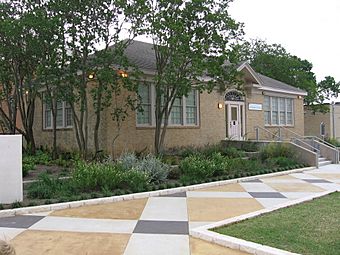George Washington Carver Museum and Cultural Center facts for kids
|
George Washington Carver Museum and Cultural Center
|
|
 |
|
| Location | 1165 Angelina St Austin, Texas, USA |
|---|---|
| Built | 1926 |
| MPS | East Austin MRA |
| NRHP reference No. | 05000241 |
Quick facts for kids Significant dates |
|
| Added to NRHP | March 30, 2005 |
The George Washington Carver Museum and Cultural Center is a special place in Austin, Texas. It's a museum and a cultural center all in one! This building used to be a library, named after the famous scientist George Washington Carver. Since 2005, it has been recognized as an important historical site on the National Register of Historic Places.
Contents
History of the Carver Center
From Library to Museum
The original building was built in 1926. It was a small wooden building. In 1933, it was moved to Angelina Street. This was done to serve the African-American community in Austin.
For many years, it was known as the "Colored Branch" library. In 1947, it was renamed the George Washington Carver Library. This honored the famous inventor and scientist. The library served the community until 1979.
A new, modern library was built next door. After that, work began to turn the old building into a cultural center. The museum officially opened its doors on October 24, 1980. It was later made even bigger with a new facility in 2001.
The original building has a special design called Colonial Revival style. Because of its history and design, it was added to the National Register of Historic Places in 2005.
Juneteenth Memorial Monument
Understanding Juneteenth
The Juneteenth Exhibit is a very important part of the George Washington Carver Museum. It helps visitors understand what freedom meant to formerly enslaved African Americans. The exhibits use videos and displays to teach about Juneteenth.
You can learn about the first Juneteenth celebrations. You can also see how people celebrate it today. The exhibit also teaches about Texas's role in the Civil War. It explains why Juneteenth is important for everyone in America.
The Juneteenth Sculptures
The Juneteenth Memorial Sculpture Monument opened on June 27, 2015. It has five bronze figures. These figures tell the story of Juneteenth. There is also a timeline paved on the ground.
This timeline shows the history of Black people in the Americas. It goes from the Middle Passage to the Emancipation Proclamation. It leads to a special Bell of Freedom.
Artists Adrienne Rison Isom and Eddie Dixon created these sculptures. Adrienne Rison Isom is from Austin. She made three of the sculptures: the Freed Man, the Freed Woman, and the Child. Eddie Dixon created the other two: the Law Maker and the Pastor.
The Story in the Sculptures
The sculptures show how the news of freedom spread. Juneteenth started on June 19, 1865. On that day, General Gordon Granger read an order. This order made the Emancipation Proclamation law in Texas.
First, the Law Maker learned about freedom. Then, the news reached the Pastor. The Pastor represents faith leaders in the African American community. The Pastor then told the enslaved people, shown by the Freed Man and Freed Woman. They shared the news with the youth, represented by the Child figure.
There is also an empty space in the monument. Visitors can stand there. This makes them part of the story. It reminds them to remember, reflect, and share the story of freedom with others.
See also

